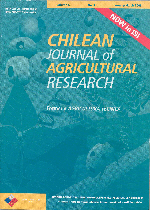
|
Agricultura Técnica
Instituto de Investigaciones Agropecuarias, INIA
ISSN: 0365-2807
EISSN: 0365-2807
Vol. 61, No. 3, 2001, pp. 352-366
|
 Bioline Code: at01037
Bioline Code: at01037
Full paper language: Spanish
Document type: Research Article
Document available free of charge
|
|
|
Agricultura Técnica, Vol. 61, No. 3, 2001, pp. 352-366
| en |
Economic Impact Analysis of the INIA-CCU Agreement for Barley Breeding Research
Campos, Arturo M. & Beratto, Edmundo M.
Abstract
In Chile barley (
Hordeum vulgare
L.) is produced mainly for beer production. In 1976, the Chilean Agricultural
Research Institute (INIA) and the Compañía Cervecerías
Unidas (CCU), the most important beer producer in the country, signed
an agreement to initiate breeding research to produce both high yield
and high quality malting cultivars in order to be distributed under contract
to barley producers. The new varieties created under this agreement have
been distributed to the producers under a system of contract production.
From 1978 to 1999, INIA introduced the Aramir variety and created three
new varieties, Granifen INIA/CCU, Acuario INIA/CCU and Libra INIA/CCU,
which were distributed in the central and southern part of the country,
where they demonstrated good adaptability, yield and quality compared
to Aramir. The results indicate the internal rate of return reached 51.98%
when the price elasticities for demand and supply were - 0.54 and 1.06
respectively. The net social benefit calculated was $5,359 million pesos,
where the producer surplus was equivalent to 64,9% of the total net social
benefit of the malting breeding research.
Keywords
barley, agricultural research, economic surplus, Chile, Hordeum vulgare
|
| |
| es |
Análisis del Impacto Económico del Contrato INIA-CCU para Mejoramiento Genético de Cebada Cervecera
Campos, Arturo M. & Beratto, Edmundo M.
Resumen
En Chile la producción de cebada (
Hordeum vulgare
L.), se destina principalmente a la fabricación de malta y cerveza.
En 1978, el Instituto de Investigaciones Agropecuarias (INIA) y la Compañía
Cervecerías Unidas (CCU), la más importante empresa productora
de cerveza del país, firmaron un convenio de investigación con
el propósito de iniciar trabajos de mejoramiento genético para
producir variedades de cebada con altos rendimientos y elevada calidad
maltera. Las nuevas variedades creadas a través de este convenio
han sido entregadas por CCU a los productores bajo un sistema de contrato
de producción. Desde 1978 hasta 1999, INIA introdujo la variedad
Aramir y creó las variedades Granifén INIA/CCU, Libra INIA/CCU
y Acuario INIA/CCU, que han sido cultivadas en el centro y sur del país,
demostrando buena adaptación, rendimiento y calidad, comparadas Aramir.
De acuerdo a los resultados, la tasa interna de retorno para este convenio
alcanzó a 51,98%, cuando las elasticidades precio de la demanda y
la oferta calculadas fueron - 0,54 y 1,06 respectivamente. El beneficio
social neto calculado alcanzó a 5.359 millones de pesos, en donde
el excedente del productor fue equivalente a 64,9% de los beneficios sociales
netos de la investigación en mejoramiento genético de la cebada
en Chile.
Palabras-clave
cebada, investigación agrícola, excedente económico, Chile, Hordeum vulgare
|
| |
© Copyright 2001 - Instituto de Investigaciones Agropecuarias, INIA (Chile)
Alternative site location: http://www.inia.cl/at/agritec.htm
|
|
